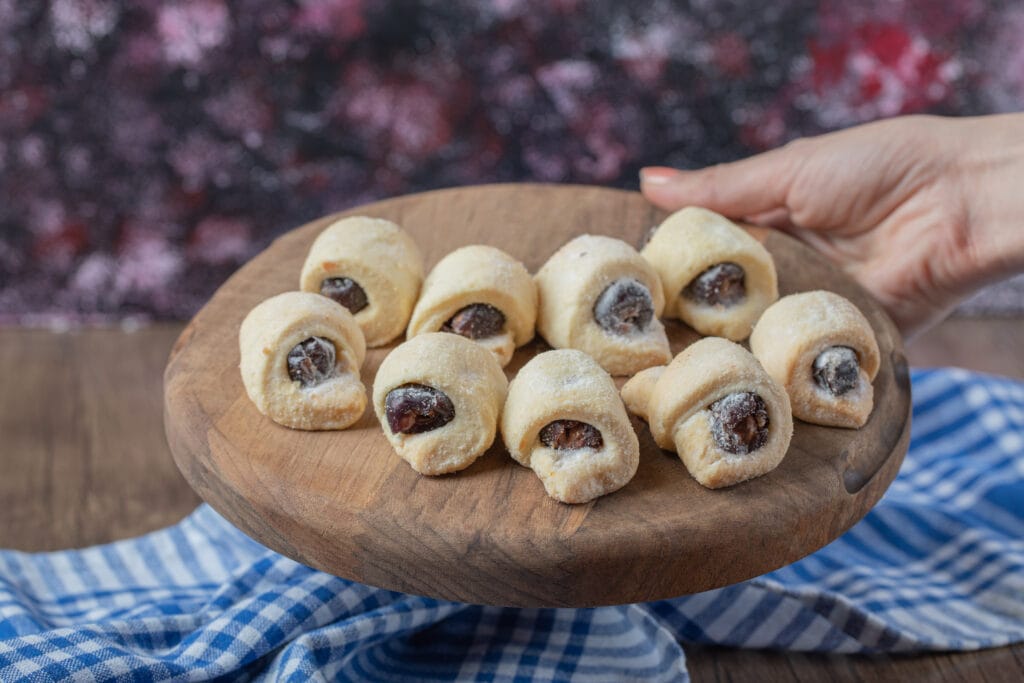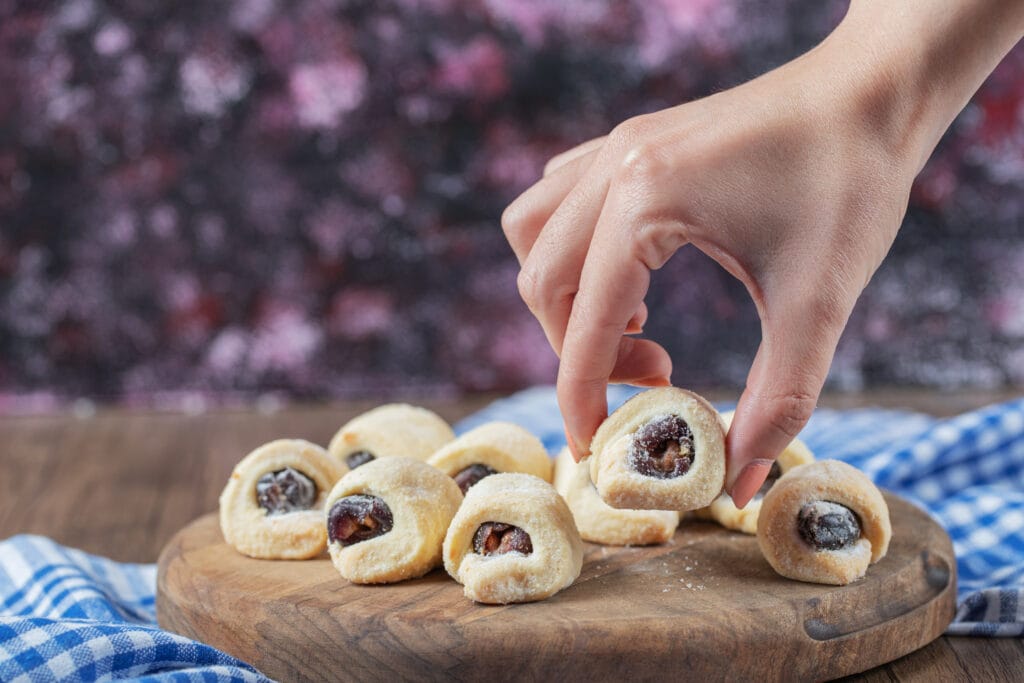Have you ever baked thumbprint cookies and wondered, why do thumbprint cookies crack when you press the center? This common issue can be frustrating; however, the causes are often simple and easy to address. Factors such as dough consistency, baking temperature, and shaping techniques play a significant role in achieving flawless cookies. In this guide, we’ll not only explain why thumbprint cookies crack but also share practical tips to prevent and fix those pesky imperfections.
For a deeper understanding of cookie science, check out King Arthur Baking’s guide on cookie troubleshooting.
Cracking in thumbprint cookies is often caused by dry or overworked dough. For instance, over-mixing can make the dough tough, while excess flour leads to dryness. Additionally, how you shape and bake the cookies impacts their structure. Therefore, paying attention to the dough’s consistency and handling is essential for avoiding cracks.
Table of Contents
Understanding the Problem: Why Do Thumbprint Cookies Crack?
Troubleshooting Common Issues
To prevent cracks, it’s important to address dough preparation, shaping techniques, and baking conditions. First, ensure your butter is softened to room temperature. Next, measure your flour carefully, as even slight over-measurements can lead to dryness. Finally, mix the ingredients gently to avoid overworking the dough.
Preventing Issues: Practical Tips for Perfect Thumbprint Cookies
While some cracks are inevitable, most can be prevented by following these steps:
- Chill the Dough: Chilling prevents spreading and helps maintain the dough’s elasticity. However, be careful not to over-chill, as this can make the dough too firm to shape.
- Shape Gently: When pressing the center, apply light pressure. For example, using a spoon instead of your thumb may reduce the risk of tearing.
Recovering from Cracks
If cracks still appear, don’t worry! Simply smooth them with damp fingers before baking. Alternatively, use a decorative drizzle or filling to mask imperfections. Therefore, even if your cookies aren’t perfect, they’ll still taste delicious.
Troubleshooting Thumbprint Cookies
Step 1: Perfecting Dough Preparation
The foundation of any successful cookie lies in its dough. To avoid cracking:
- Use room-temperature butter for a smooth, pliable base. If it’s too soft, the cookies will spread; too cold, and they’ll crack.
- Measure ingredients accurately, especially flour. Spoon the flour into your measuring cup and level it with a knife for precision.
For a foolproof recipe, refer to the guide on peanut butter thumbprint cookies, which outlines the importance of balanced dough composition.
Step 2: Mastering Shaping Techniques
Proper shaping minimizes cracks and ensures uniform cookies:
- Roll the dough into smooth, even balls. Any seams or inconsistencies can create weak spots.
- Gently press your thumb into the center. Avoid pressing too deeply or forcefully, as this can tear the dough.
For inspiration on elegant shaping techniques, explore the recipe for Earl Grey cookies, which emphasizes a delicate approach.
Step 3: Baking at the Right Temperature
Bake your cookies at a moderate temperature, usually around 325°F to 350°F. This ensures even baking and reduces the risk of cracking due to rapid expansion.

Preventative Tips for Crack-Free Thumbprint Cookies
1. Chill Your Dough
While chilled dough is less sticky and easier to handle, ensure it’s not overly cold. A 30-minute chill is typically ideal. If the dough becomes too firm, let it sit at room temperature for a few minutes before shaping.
2. Experiment with Fillings
Certain fillings, like soft caramel or creamy chocolate, can mask minor cracks. Adding the filling post-baking, as done in recipes like pumpkin banana loaf cookies, ensures a polished look.
3. Use Alternative Ingredients
For a softer dough, consider incorporating ingredients like cream cheese or yogurt, which add moisture and flexibility.
Enhancing Texture and Flavor
Once you’ve mastered crack-free cookies, elevate their texture and flavor:
- Alternative Flours: Almond flour or oat flour can add a nutty or hearty texture.
- Unique Fillings: Experiment with lemon curd, Nutella, or savory options like herbed cheese.
- Flavor Enhancers: Incorporate spices like cinnamon, nutmeg, or citrus zest for an aromatic twist.
Step-by-Step Guide to Perfect Thumbprint Cookies
Follow these steps for flawless results:
Ingredients:
- 1 cup unsalted butter, softened
- ½ cup granulated sugar
- 1 teaspoon vanilla extract
- 2 cups all-purpose flour
- Optional fillings: jam, chocolate, caramel
Instructions:
- Prepare the Dough:
- Cream butter and sugar until light and fluffy.
- Add vanilla and gradually mix in the flour until just combined.
- Chill the Dough:
- Wrap the dough in plastic wrap and refrigerate for 30 minutes.
- Shape the Cookies:
- Roll dough into 1-inch balls. Place them on a baking sheet lined with parchment paper.
- Gently press your thumb into the center of each ball to create an indentation.
- Bake:
- Preheat the oven to 350°F. Bake cookies for 12–15 minutes, or until edges are lightly golden.
- Add Fillings:
- Allow cookies to cool slightly before filling the centers with your desired topping.
Recovering from Cracks
Even with the best efforts, cracks can still happen. Here’s how to recover:
- Before Baking: Smooth cracks with damp fingers or a small spatula.
- After Baking: Use the filling to cover imperfections or add decorative elements like powdered sugar or drizzled chocolate.
FAQs About Thumbprint Cookies
Why Do My Cookies Spread Too Much?
Soft butter or insufficient flour can cause spreading. Ensure the dough is properly chilled before baking.
Can I Use Gluten-Free Flour?
Yes! Gluten-free flour blends work well but may require a binding agent like xanthan gum.
How Can I Store Thumbprint Cookies?
Store cookies in an airtight container at room temperature for up to a week. For longer storage, freeze them in a single layer.
What Are the Best Fillings?
Classic jams like raspberry or apricot are popular, but you can also try ganache, lemon curd, or savory options.
Creative Variations of Thumbprint Cookies
While traditional thumbprint cookies are delightful, there’s room for creativity:
- Savory Options: Incorporate cheese or herb fillings for an appetizer twist.
- Holiday-Themed: Add festive sprinkles or use colored dough for special occasions.
- Unique Shapes: Instead of circular cookies, try shaping them into hearts or stars.
For more innovative ideas, the guide on peanut butter thumbprint cookies offers tips for customizing your cookies.
By following these strategies, you’ll master the art of crack-free thumbprint cookies. With practice, experimentation, and attention to detail, your cookies will not only taste amazing but look professional too. For additional baking tips and creative recipes, explore the Earl Grey cookies and pumpkin banana loaf cookies on Element Recipes.
Happy baking!


